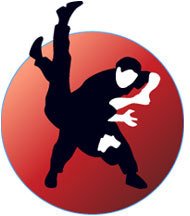By Joel Persinger
I am a great believer that techniques, without a deep understanding of principle, are useless. One simple example is this: if I don’t understand the use of kinetic energy, learning how to punch will yield punches which are weak and ineffective. Yet another example is that of body type and size. Say what you will, but in my world, size matters. It is an indisputable fact that techniques which work for a small person when combating an equally small person may not work as effectively when the little guy is trying to fight off a six foot, six inch, 350 pound hulk. Likewise, techniques which work for a person with a low center of gravity may not work as well for a person with a high center of gravity when applied against the same or a similar opponent.
In addition to the basics of physics, body style, age, relative agility and size there is also the issue of martial style. Techniques which fit well into one martial system may be cumbersome and unworkable when used within another. Thus my friend & instructor Mike Patterson’s analogy of building a car,
“Mixing and matching is analogous to grabbing a hodgepodge of car parts from different makes and models to build a working automobile. You might be able to build something that looks like a car but it will not run effectively, if it runs at all, simply because the parts are not made to work together.”
In today’s world of martial arts, mixing and matching has taken on a life of its own. Gee, one has to look no further than the term, “Mixed Martial Arts” to see the point. The result has been a significant “movement” creating folks who look like martial artists, but whose collection of techniques often does not work together effectively, or at least not as effectively as it might. Yes, a rear naked choke is a rear naked choke and a hip throw is a hip throw. But, when techniques are simply piled upon one another without any foundational guiding principle, there is no way for the practitioner to understand and evaluate what fits and what does not.
Now, before you get out your poison pen and start sending me hate mail accusing me of bashing mixed martial artists, let me make a few things clear. Not one martial style known today was created in a vacuum. All of them evolved over time as guiding principles were established and perfected and as techniques were explored and honed. It can also be accurately said that martial styles have borrowed from each other by taking parts of other arts which fit well into the system and, in many cases, adapting them further to make them fit even better. Since time is not static and since our ancestors did not freeze martial styles in place for all eternity, we shouldn’t either. We should learn from the example of those who came before us by learning from other arts thereby exploring new frontiers.
Where we have lost our way is not in that we have elected to bring new and different techniques into the fold. Rather, it is that we have forgotten to let the foundations of our arts guide us as we incorporate new ideas. For example: I have spent most of my history studying the Karate style arts. Along the way, I have studied internal Chinese arts a little and Filipino martial arts a lot. In fact, my first instructor taught a Karate style art with Arnis De Mano mixed in for good measure. As a consequence, the foundation for my martial arts journey was firmly built upon a mixture of Karate and Filipino Martial Arts. They are very different, and yet my first instructor was able to put them together so that they worked in unison. Thus, my foundation is different than most. But it is strong.
On the other hand, I have a student (who, by the way, teaches me too). He has been studying Hsing-I for twenty years or more. As I teach him the various aspects of Filipino Martial Arts he relates what he learns to his foundation. Consequently, his movement and his application of the techniques he learns from me are very different from mine. Some things which work well for me, will not work well for him and vice versa. Some things may work well for him only after he has adapted them to fit firmly upon his foundation. This is not because the techniques don’t work. It is because our foundations and the guiding principles upon which they were fashioned are different.
The bottom line is that learning new techniques is fun and very positive. However, there is a difference between collecting disjoined techniques as you might pile up unrelated car parts in a junk yard and carefully examining, honing and shaping new techniques to fit well upon your foundation, just as you might select premium, well fitting parts with which to build your car. I submit that that the latter approach will help you become a more complete martial artist, while the former may leave you only a collector of junk.
Tuesday, April 15, 2008
Subscribe to:
Post Comments (Atom)

No comments:
Post a Comment